Affiliate links on Android Authority may earn us a commission. Learn more.
Apple AirPods Pro (2nd gen) vs AirPods (3rd gen): Which should you buy?


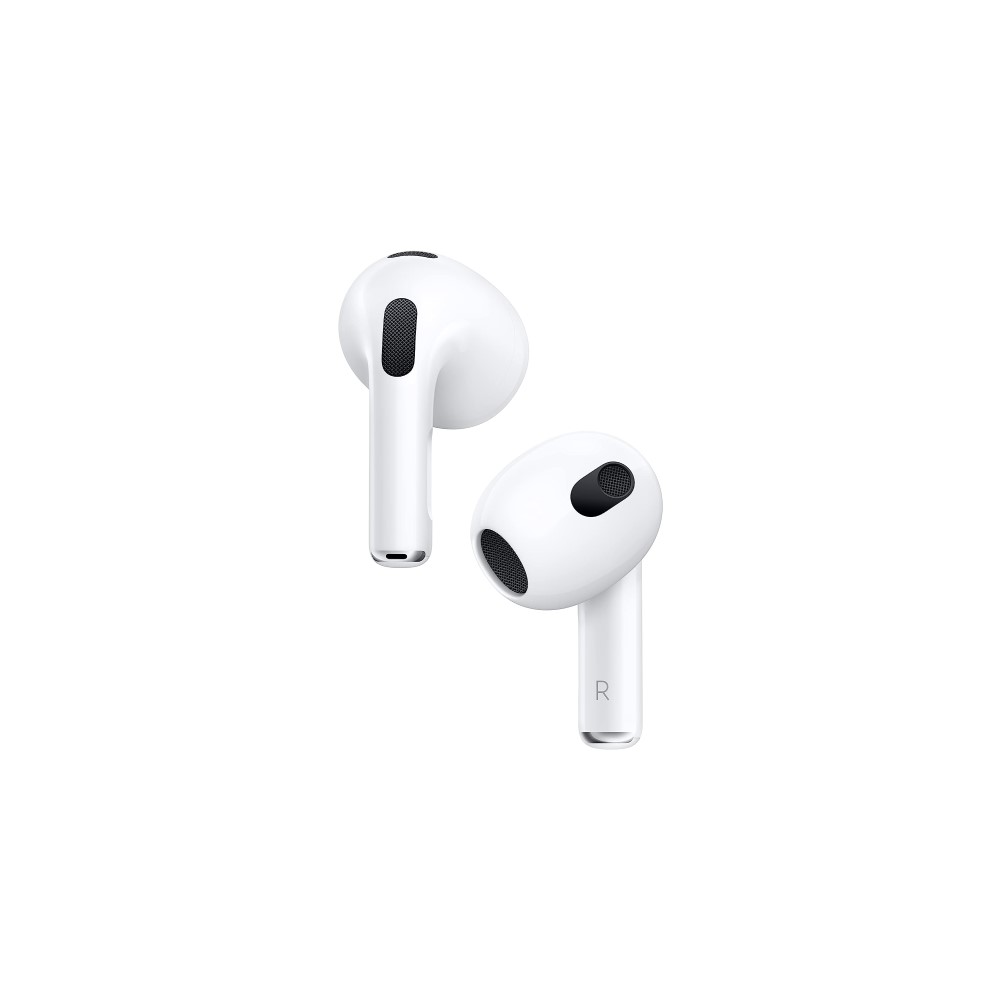
Apple is the top dog when it comes to flagship earbuds, and each of its AirPods sell like hotcakes. In our AirPods Pro 2 vs AirPods 3 face-off, we’ll compare these two famous earbuds. The AirPods Pro (2nd generation) are pricier and more premium, but the AirPods (3rd generation) may fit your lifestyle better. Let’s review the earbuds’ design, performance, sound quality, and more to see which ones make the most sense for your needs.
Apple AirPods Pro 2 vs AirPods 3: At a glance
By and large, the AirPods Pro (2nd generation) and AirPods (3rd generation) are quite similar. Here's a brief introduction to their main differences:
- The AirPods Pro 2 have ear tips, and the AirPods 3 do not.
- The AirPods Pro 2 have active noise canceling (ANC) and Adaptive Transparency, both of which the AirPods 3 lack.
- The AirPods Pro 2 charging case has a U1 chip and speaker for more location tracking options than the AirPods 3 case.
- The AirPods Pro 2 cost $249, and the AirPods 3 start at $169.
Apple AirPods Pro 2 vs AirPods 3: Specs
| AirPods Pro (2nd generation) | AirPods (3rd generation) | |
|---|---|---|
Dimensions | AirPods Pro (2nd generation) Earbud: 30.9 x 21.8 x 24.0mm Case: 45.2 x 60.6 x 21.7mm | AirPods (3rd generation) Earbud: 30.79 x 18.26 x 19.21mm Lightning/MagSafe case: 46.40 x 54.40 x 21.38mm |
Weights | AirPods Pro (2nd generation) Earbud: 5.3g Case: 50.8g | AirPods (3rd generation) Earbud: 4.28g Lightning/MagSafe case: 37.91g |
Bluetooth connectivity | AirPods Pro (2nd generation) Bluetooth 5.3 SBC, AAC | AirPods (3rd generation) Bluetooth 5.0 SBC, AAC |
Water resistance | AirPods Pro (2nd generation) Earbuds: IPX4 Case: IPX4 | AirPods (3rd generation) Earbuds: IPX4 Case: IPX4 |
Listening time | AirPods Pro (2nd generation) Earbuds, ANC on: 6 hours Earbuds, personalized Spatial Audio and head tracking: 5.5 hours Earbuds and case: up to 30 hours | AirPods (3rd generation) Earbuds: 6 hours Spatial Audio: 5 hours Earbuds and case: 30 hours |
Talk time | AirPods Pro (2nd generation) Earbuds ANC on: 4.5 hours Earbuds and case: 24 hours | AirPods (3rd generation) Earbuds: 4 hours Earbuds and case: 20 hours |
Charging | AirPods Pro (2nd generation) Lightning MagSafe Wireless | AirPods (3rd generation) Lightning or Lightning and MagSafe, depends on variant |
Audio hardware | AirPods Pro (2nd generation) Custom high-excursion Apple driver Custom high dynamic range amplifier Vent system for pressure equalization | AirPods (3rd generation) Custom high-excursion Apple driver Custom high dynamic range amplifier |
Sensors | AirPods Pro (2nd generation) Dual beamforming microphones Inward-facing microphone Skin-detect sensor Motion-detecting accelerometer Speech-detecting accelerometer Force sensor Touch control | AirPods (3rd generation) Dual beamforming microphones Inward-facing microphone Skin-detect sensor Motion-detecting accelerometer Speech-detecting accelerometer Force sensor |
Device compatibility | AirPods Pro (2nd generation) Latest versions of iOS, macOS, Apple Watch, Apple TV Android: Limited Bluetooth features only Windows: Limited Bluetooth features only | AirPods (3rd generation) Latest versions of iOS, macOS, Apple Watch, Apple TV Android: Limited Bluetooth features only Windows: Limited Bluetooth features only |
Chipset | AirPods Pro (2nd generation) H2 (earbuds) U1 (case) | AirPods (3rd generation) H1 (earbuds) |
Personalized Spatial Audio with head tracking | AirPods Pro (2nd generation) Yes | AirPods (3rd generation) Yes |
Noise canceling | AirPods Pro (2nd generation) Yes | AirPods (3rd generation) No |
Transparency | AirPods Pro (2nd generation) Yes, adaptive | AirPods (3rd generation) No |
Ear tip selection | AirPods Pro (2nd generation) XS, S, M, L | AirPods (3rd generation) None |
Release date | AirPods Pro (2nd generation) September 23, 2022 | AirPods (3rd generation) October 26, 2021 |
Price | AirPods Pro (2nd generation) $249 | AirPods (3rd generation) $169 / $179 |
The AirPods Pro (2nd generation) and AirPods (3rd generation) share a similar look and feel. The AirPods 3 are basically the AirPods Pro 2 without ear tips. Due to the AirPods Pro 2’s ear tips, you get a more stable fit than the AirPods 3. When reviewing the AirPods Pro 2, I found the more stable fit proved better for exercise. Further, with the AirPods Pro 2, you get the added benefit of passive isolation from the ear tips, which is necessary for the earbuds’ excellent ANC.
When you want to hear your surroundings with the AirPods Pro 2, there’s Adaptive Transparency. This amplifies background noise through the earbuds to keep you aware of your surroundings. The AirPods 3 lack Transparency because they don’t block out background noise. Instead, you’re constantly hearing your surroundings with the AirPods 3.
Although both sets of buds have force sensors, only the AirPods Pro (2nd generation) support onboard volume controls. To adjust the volume of your AirPods 3, you need to reach for your phone or ask Siri to adjust it.
The AirPods Pro 2 come with ear tips, which promote a more stable and comfortable fit.
Another difference: the AirPods Pro 2 case houses Apple’s proprietary U1 chip for location tracking. Apple also integrated a speaker into the AirPods Pro 2 case, a first for the AirPods line. With the Find My app, listeners can see the case’s location on a map and force its speaker to emit a sound. You cannot locate the AirPods 3 case on a map through Find My, just the individual AirPods.
Both sets of earbuds support Apple’s Spatial Audio with head tracking. Spatial audio is a catch-all term for 360-degree audio playback. It can make movies, TV shows, and even music more immersive. You also get the same IPX4 water-resistant rating with the AirPods and their cases. This means both sets of AirPods can endure water sprays, just don’t drop them in the sink or a pool.
Apple AirPods Pro 2 vs AirPods 3: Noise canceling and isolation
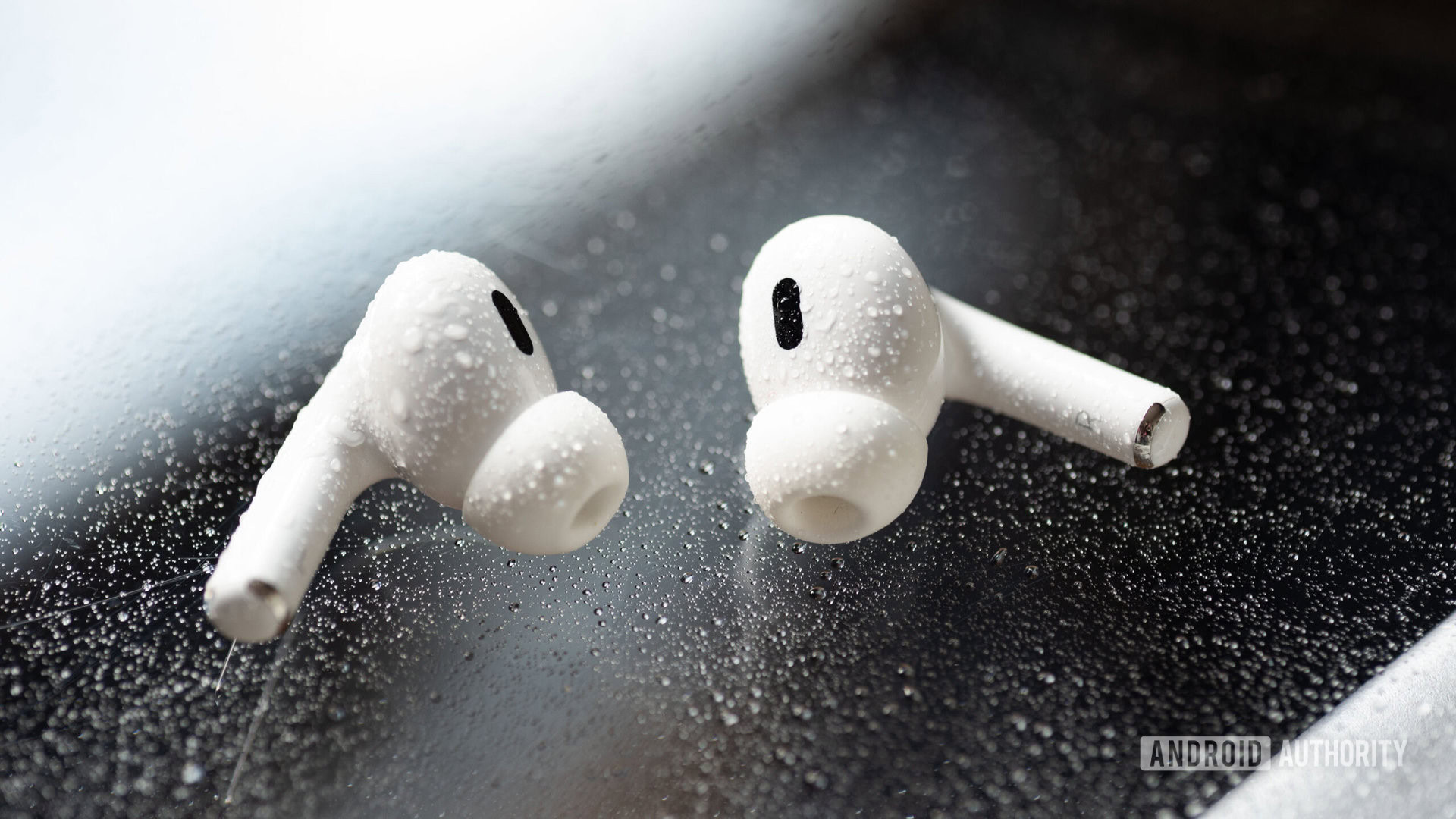
If you want to enjoy your music in silence, get the AirPods Pro 2 instead of the AirPods 3. I’ve used the AirPods Pro 2 on several flights and am always grateful for their ANC. That said, noise canceling isn’t the be-all, end-all. Sometimes, it’s beneficial to hear what’s going on around you. After all, there’s an entire market dedicated to open ear headphones. If you want to hear your music and your environment simultaneously, the AirPods 3 make more sense than the AirPods Pro 2.
The AirPods (3rd generation) cover your ear canals but don’t create a cogent seal to isolate you from the world. You can see how this affects isolation performance in the comparison chart below. To interpret the data, know that the higher the line, the more noise the earbuds block out. Blocking out frequencies from 0-2,040Hz is the most important for good isolation.
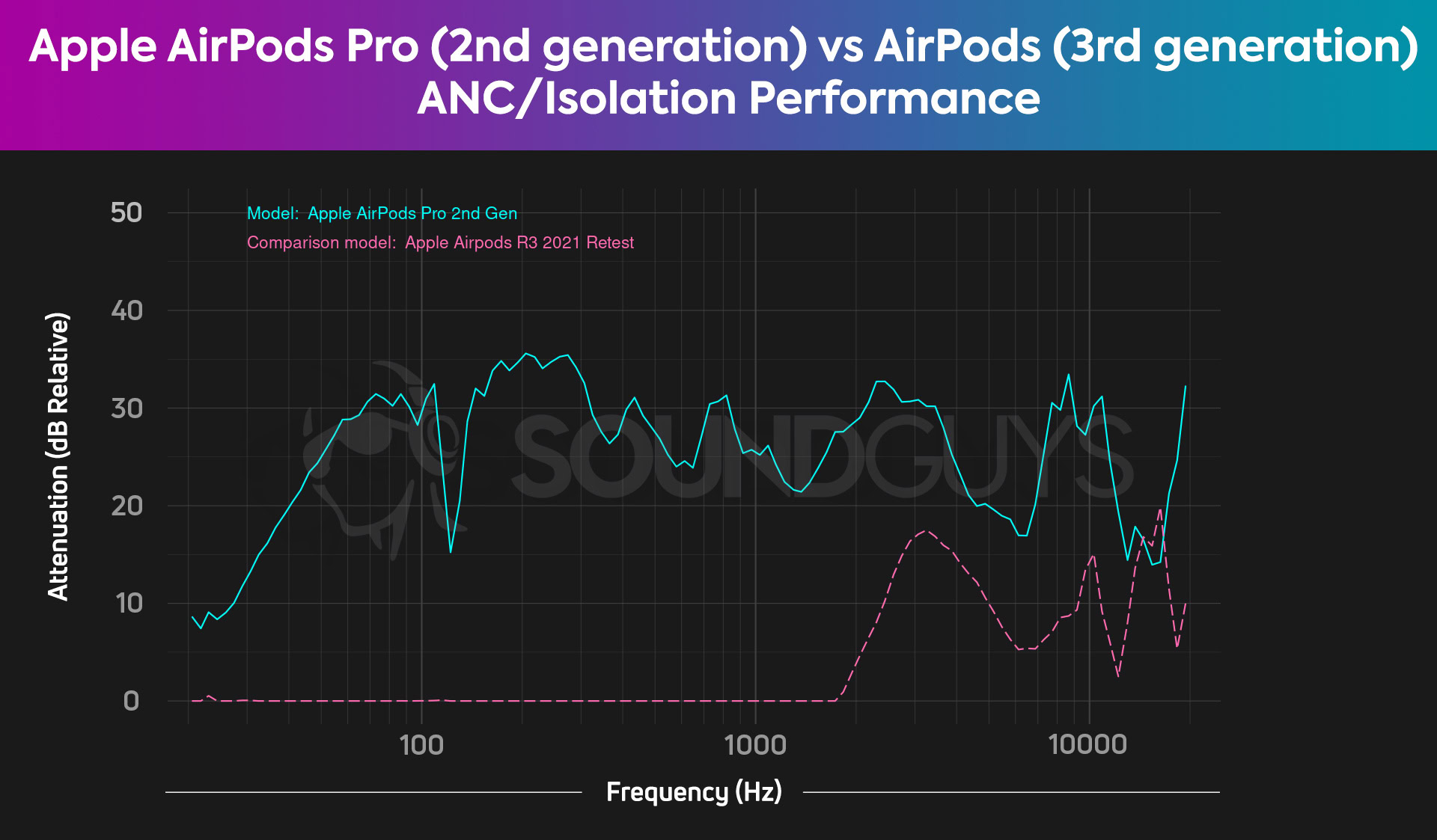
The dashed pink line represents the non-ANC AirPods 3. As you can see, the AirPods 3 line blocks out 0dB of noise until just shy of 2,000Hz. Compare that to the AirPods Pro (2nd generation), represented by the solid cyan line. The AirPods Pro 2 do much more to block out all frequencies. In use, you’ll notice that low rumbles from traffic outside your office window or airplane engines are quieter with the AirPods Pro 2 (ANC on). Listening to the AirPods Pro 2 with ANC quiets these low frequencies by up to 91% compared to the AirPods 3.
Apple AirPods Pro 2 vs AirPods 3: Sound quality
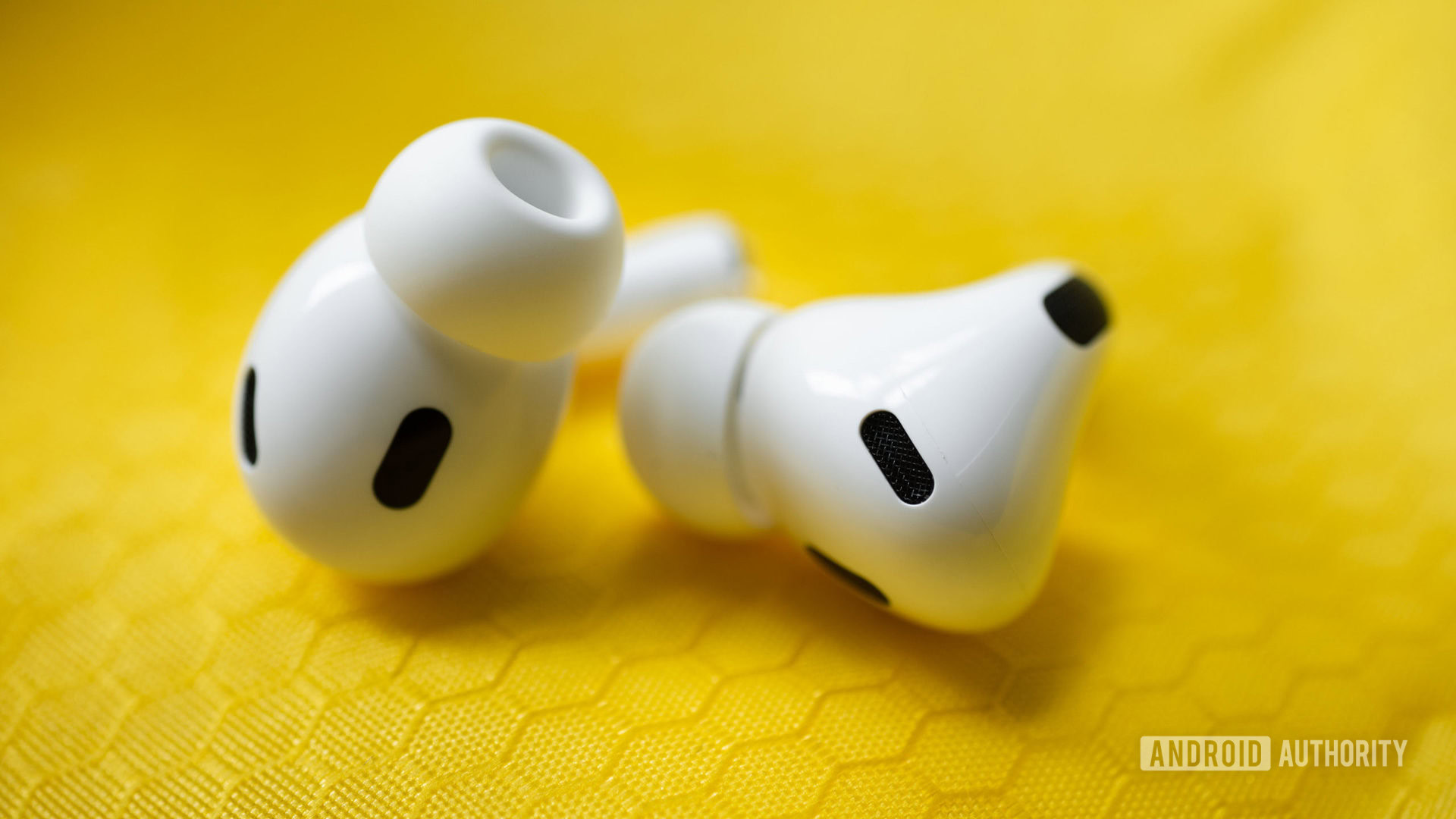
The AirPods Pro (2nd generation) sound better than the AirPods (3rd generation). With the AirPods Pro 2, you get a louder sub-bass response and can feel a thumb from your favorite song’s bass line. You’ll still hear vocal and higher-pitched instrumental detail from the AirPods Pro 2, too. In contrast to the AirPods Pro 2, the AirPods 3 severely lack sub-bass, and the treble is a touch too loud. This significant difference in loudness between the sub-bass and treble can make music sound unnatural. For instance, cymbal hits may come through louder than expected with the AirPods 3.
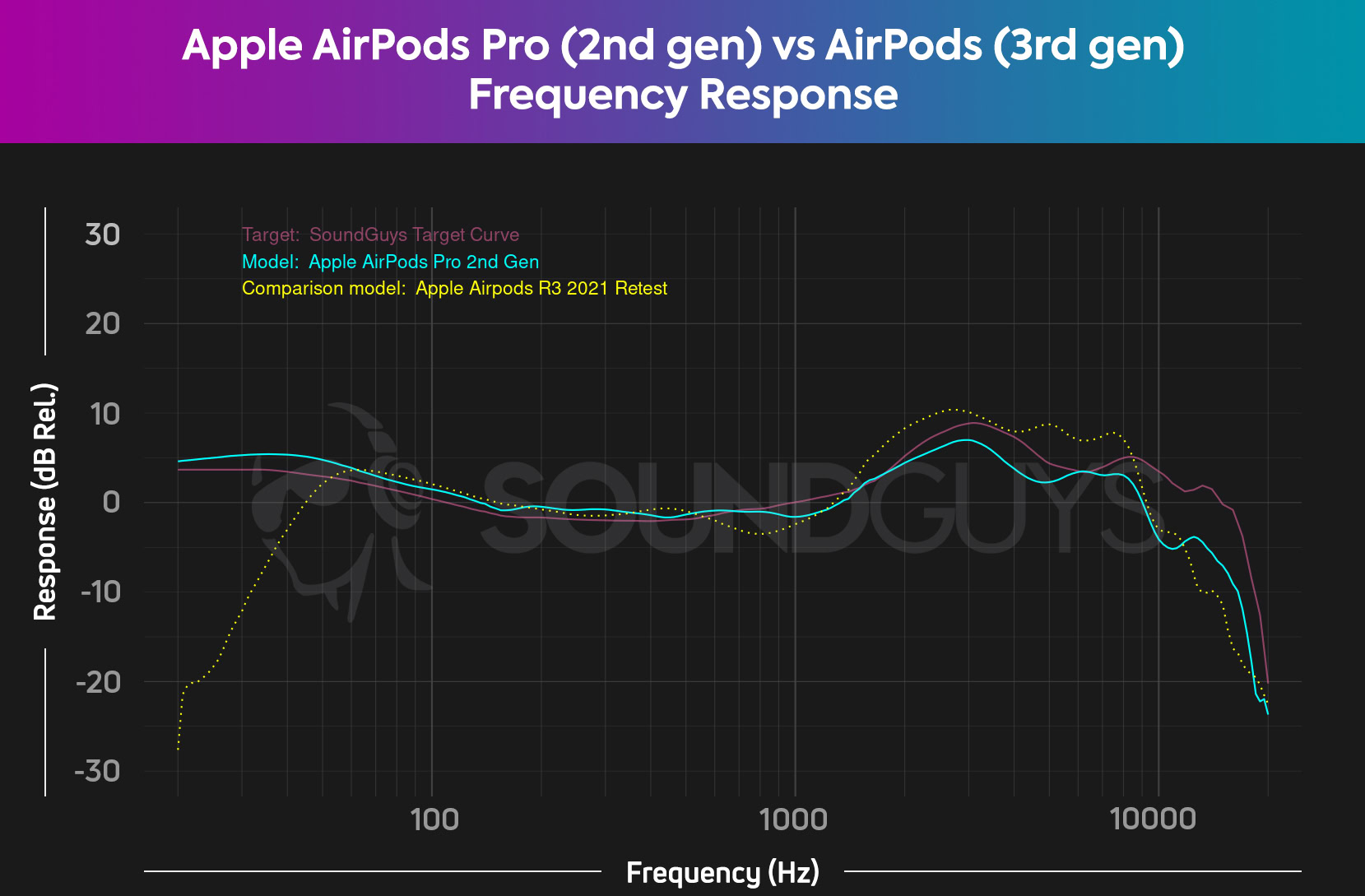
You can see how both AirPods’ frequency responses differ in the chart above. The cyan line represents the AirPods Pro 2; the yellow dotted line represents the AirPods 3; and the pink line represents SoundGuys‘ Target Curve. (SoundGuys is our audio-focused sister site.) SoundGuys posits the Target Curve as the ideal frequency response for consumer headphones and earbuds. Neither set of earbuds perfectly matches the Target Curve, but the AirPods Pro 2 are much closer.
With some earbuds, you can adjust the sound with a complimentary app, but that’s not the case with the AirPods. Even if you own an iPhone, you can’t customize the sound through the Settings app. The only way to create a custom EQ with the AirPods is with a third-party app or your music app’s equalizer.
Apple AirPods Pro 2 vs AirPods 3: Microphone quality
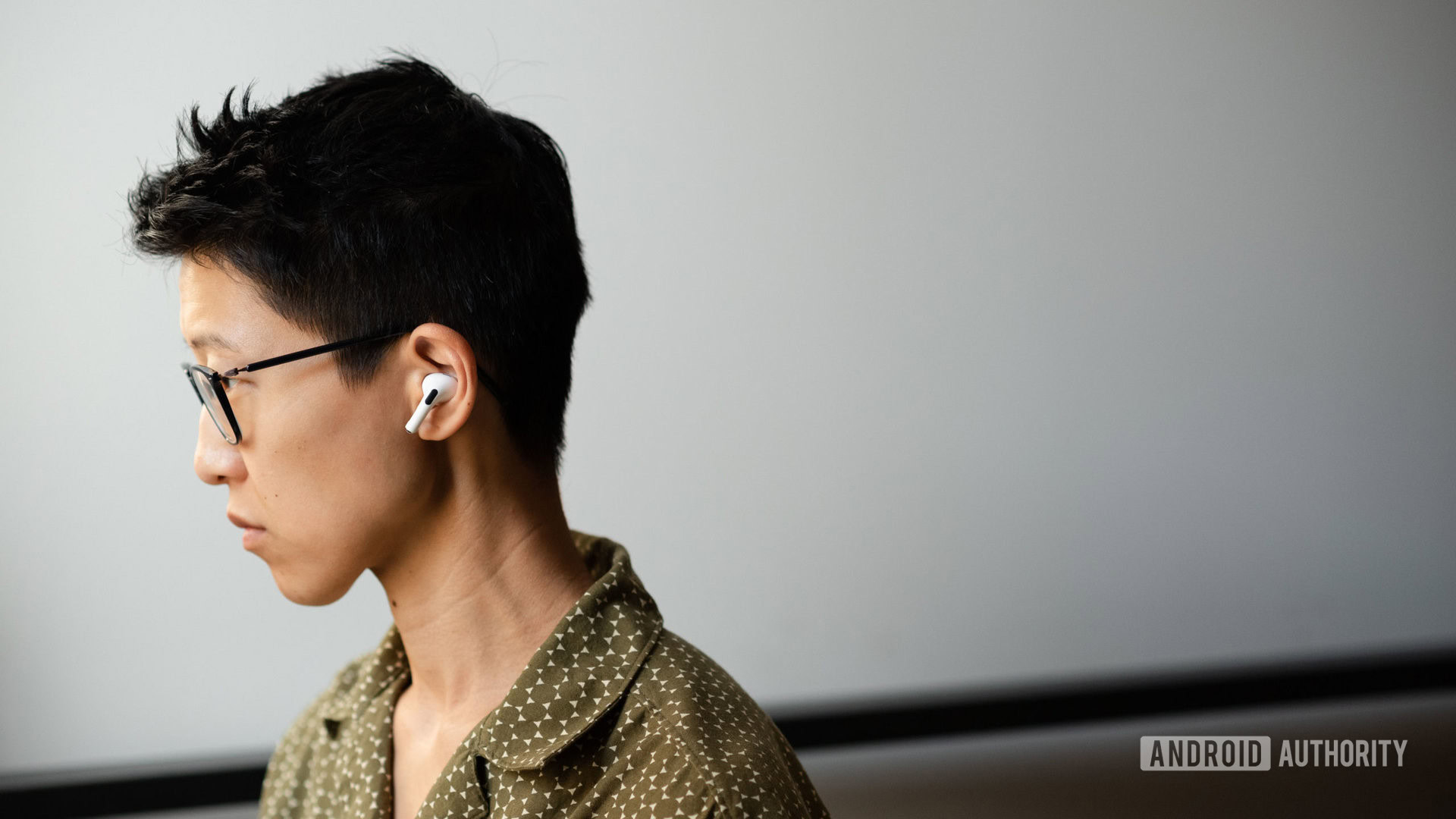
The AirPods Pro (2nd generation) and AirPods (3rd generation) have sufficient microphone quality for phone calls. In ideal conditions, the AirPods Pro 2 relay louder audio but drop the speaker’s voice occasionally. On the other hand, the AirPods 3 relay slightly quiet audio but rarely drop the speaker’s voice in ideal conditions.
In our demos with simulated street noises, neither set of AirPods excels. The AirPods 3 transmit more background noise than the AirPods Pro 2, but the latter tends to lose the speaker’s voice slightly more often.
Apple AirPods Pro (2nd generation) microphone demo (Ideal conditions):
Apple AirPods (3rd generation) microphone demo (Ideal conditions):
Apple AirPods Pro (2nd generation) microphone demo (Street conditions):
Apple AirPods (3rd generation) microphone demo (Street conditions):
Apple AirPods Pro 2 vs AirPods 3: Battery and charging
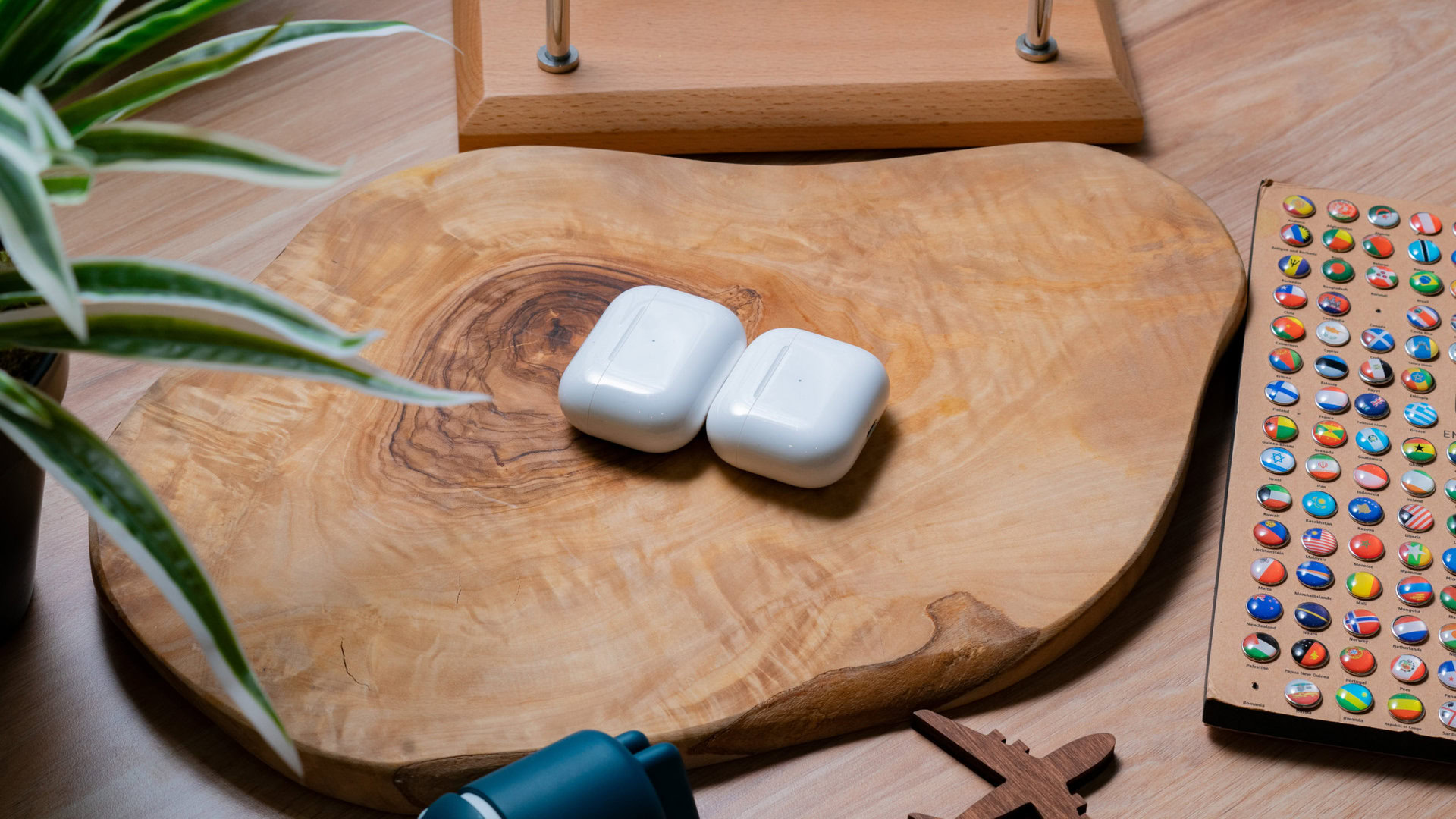
According to Apple, a single charge of the Apple AirPods Pro (2nd generation) lasts six hours with ANC, or you can get five hours, 30 minutes of talk time. The case provides an extra 24 hours of listening time, or 19 hours, 30 minutes of talk time. Officially, the AirPods (3rd generation) provide six hours of media playback on a single charge and four hours of talk time. The AirPods 3 case supplies 26 extra hours of music playback or 14 more hours of talk time.
In our testing, we subjected the AirPods Pro 2 and AirPods 3 to constant music playback peaking at 75dB (SPL). We enabled ANC on the Airpods Pro 2, and these were the battery life results:
- AirPods Pro (2nd generation), ANC on: Five hours, 43 minutes.
- AirPods (3rd generation): Six hours, 21 minutes.
A five-minute charge of either set of AirPods provides one hour of listening or talk time. By default, both AirPods cases support Lightning charging. The AirPods Pro 2 come with a MagSafe charging case. To get a MagSafe case with the AirPods 3, you’ll pay $179 instead of $169.
Apple AirPods Pro 2 vs AirPods 3: Price
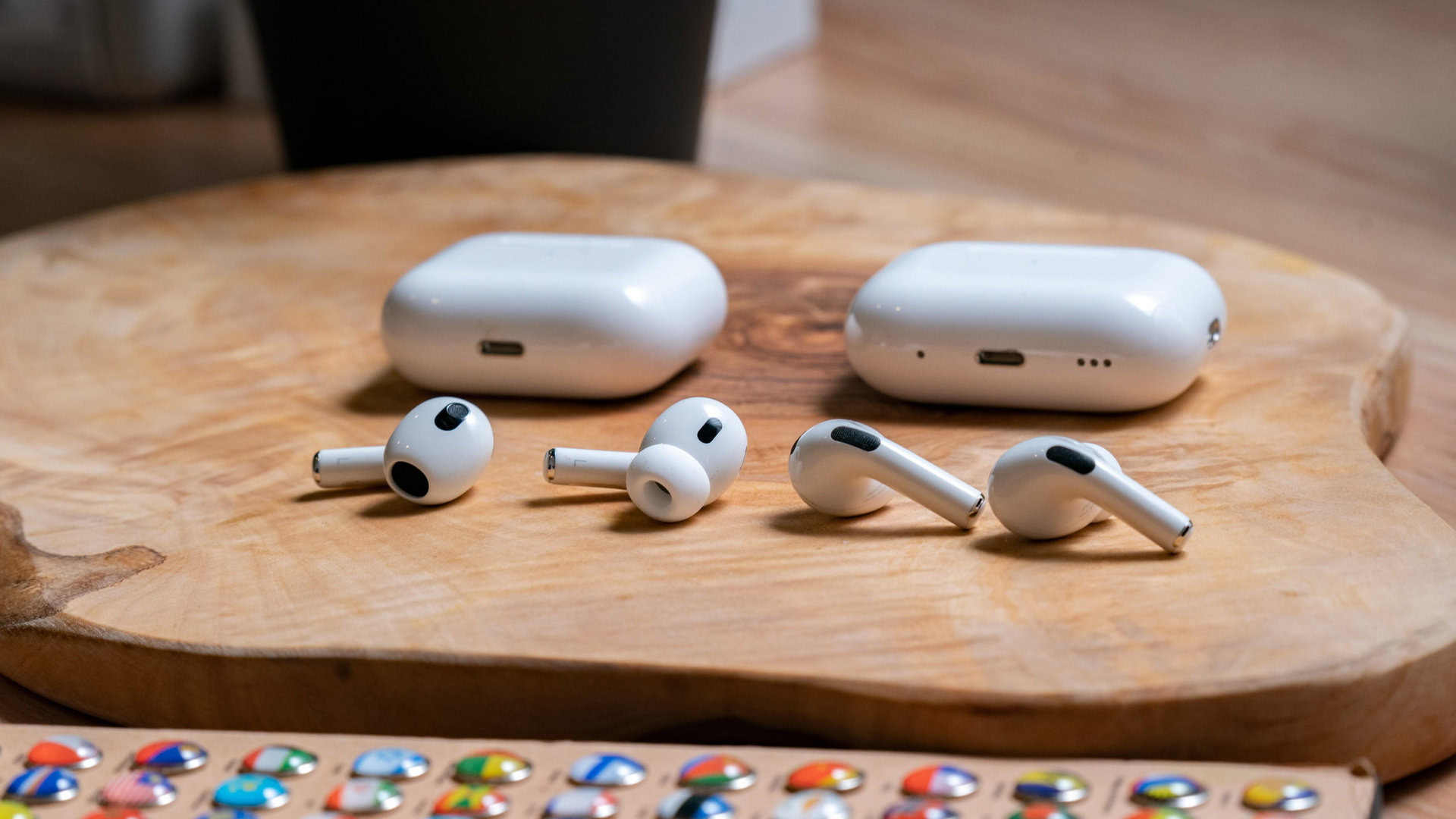
- Apple AirPods Pro 2: $249
- Apple AirPods 3 (Lightning case): $169
- Apple AirPods 3 (MagSafe wireless charging case): $179
The AirPods Pro (2nd generation) retail for $249, matching the original AirPods Pro. The AirPods (3rd generation) are much cheaper and start at $169 for the Lightning charging case. If you want a MagSafe wireless charging case, the cost bumps up to $179. Don’t worry: the MagSafe variant also supports Lightning cable charging.
Around shopping holidays, we’ve seen the AirPods Pro 2 drop as low as $199 from big box retailers. Likewise, the AirPods 3 have gone on sale for as low as $149. If you don’t want to wait for a sale, both AirPods models are readily available from the Apple Store and other retailers like Best Buy, Target, and Amazon.
Apple AirPods Pro 2 vs AirPods 3: Which earbuds should you buy?
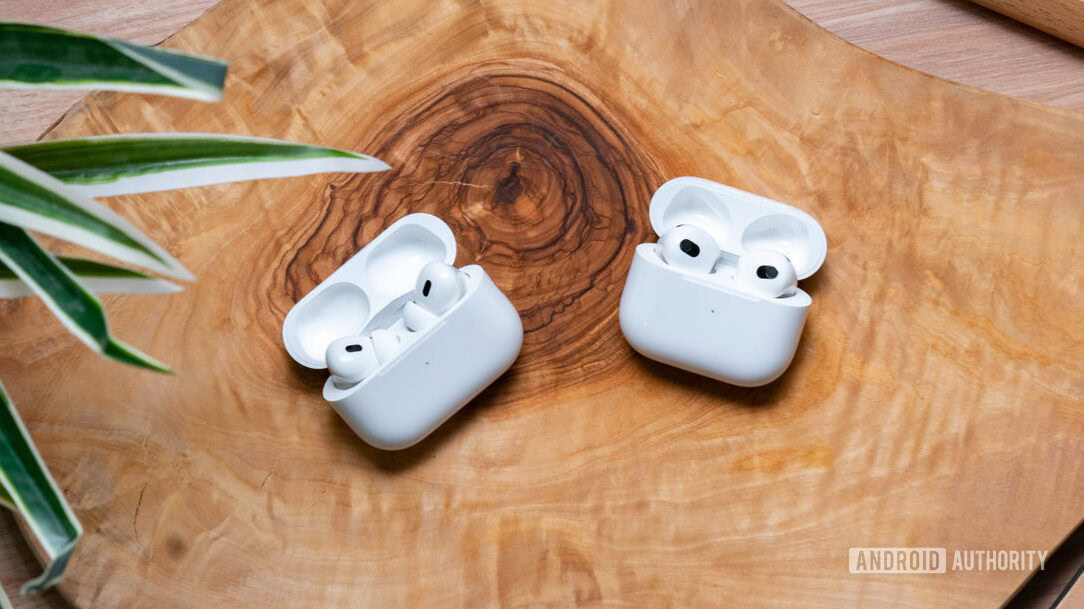
The AirPods Pro (2nd generation) and AirPods (3rd generation) are excellent earbuds, particularly for iPhone owners. The noise canceling, fit, and onboard controls are all better with the AirPods Pro 2, though. Plus, the AirPods Pro 2 have more advanced location tracking for the case.
The AirPods Pro 2 are the better earbuds for commuting, but the AirPods 3 keep you aware of your surroundings at all times.
For listeners in need of earbuds to cover their commute, conference calls, and gym sessions, the AirPods Pro 2 are the better buy. That said, some people just prefer unsealed earphones. If that resonates with you, go ahead and buy the AirPods 3. These earbuds offer an AirPods Pro-like experience without ear tips and noise canceling. Let’s not forget that the more affordable price of the AirPods 3 is appealing too.
If you already have the AirPods (3rd generation), it could be worth upgrading to the AirPods Pro (2nd generation) for ANC and better sound quality. Should you decide to upgrade, I recommend waiting for the AirPods Pro 2 to go on sale. Wireless earbud batteries rarely last longer than two years of daily use, so you’re better off avoiding the full price if you can.


